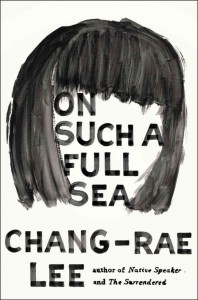Posted April 29, 2014
“On Such a Full Sea”
By Chang Rae Lee
By AISHA MOKTADIER
Chang-Rae Lee’s newest novel, “On Such a Full Sea,” is an astonishing departure from his other works in terms of its storyline, however, remains true to the author’s ability to craft language in such a way that makes it impossible for the reader to set his novel aside. A beautiful and tragic story rests between the 352 bound pages of Lee’s novel that is a graceful mix of elements reminiscent of Aldous Huxley’s “Brave New World” and Kazuo Ishiguro’s “Never Let Me Go.”
What sets the book aside from the wildly imaginative figures of other dystopian science fiction books such as “The Hunger Games,” is Lee’s creation of a world that is the product of the evils of human nature that we can already see occurring in the present. Increased industrial production, pollution of the air and water, and the breakdown of class structure are all present in Lee’s representation of America in a few years time.
The novel’s 16-year-old protagonist, Fan, is one of the Asian-ancestry workers living in B-Mor who cultivates food products for the “charter” villages, by working as a diver to clean and filter the large aquariums that house their fish. Lee’s B-Mor is also sprinkled with indoor amenities for the population to use because of the lack of the Earth’s ability to control its climate any longer. Lee writes, “Our elders will say there used to be whole seasons in between of perfectly glorious days.”
This is a stark contrast to the synthetic living arrangements of the inhabitants of B-Mor, which rely heavily on indoor areas such as shopping centers full of artificial lighting, mood-enhancing music, and the sweetness of a “seasonally perfumed” space. The population remains blissfully unaware of the sight of clearer skies, flora, and crisp autumn leaves.
Much like the gates of Hailsham, Kazuo IIshiguro’s fictional boarding school in his novel Never Let Me Go, the inhabitants of B-Mor are contained within the walls of the labor settlement and advised against the putrid smell and sickening images of what it is like beyond the confines of their better, more tolerable B-Mor.
Also similar to Ishiguro’s novel is the concept of “originals.” Ishiguro uses the term to refer to the original humans the characters in his novel are cloned from, while Lee uses “originals” to refer to the predecessors to the current inhabitants of B-Mor, who are originally from China. In both cases, the current living inhabitants of either place, whether it is Hailsham or B-Mor, are modeled to be better suited than those before them of another place and time, and also serve a purpose in catering to a greater good.
Lee’s novel is told in retrospect through the eyes of the collection of inhabitants living in B-Mor at the time of Fan’s disappearance. Evocative of Hannah Pittard’s narrative voice in her novel “The Fates Will Find Their Way,” the collective voice behind the narration in “On Such a Full Sea” finds itself consistently worrying about the novel’s protagonist, while the inhabitants of B-Mor attempt to offer their empathy in imagining what it must have felt like to endure what she had.
Where Lee writes, “For all of us here, it is difficult not to think often about that first night of Fan’s,” Pittard’s collective voice of the narrator in her own novel mirrors the same longing, saying “We lay awake and wondered all over again about Nora and her strange sister.”
Lee’s futuristic vision of America also questions the idea of class structure, and paints a vivid canvas as to what a continually growing gap between the rich and poor can become. The labor colony of B-Mor take on jobs that contribute to serving the “Charters,” or the villages where residents of great status and power live a luxurious lifestyle.
This arrangement exemplifies the sad truth that, much like in Aldous Huxley’s Brave New World where each clones is assigned to a certain class for their life’s entirety, there exists an inability for Lee’s B-Mor residents to move beyond the walls of their own labor settlement, except for the select few who get to join the Charters based on their Exams.
“On Such a Full Sea” can serve as a social critique of a rapidly globalizing world, class structure and the effects of technology and production on the lives of its human inhabitants. Lee writes “She [Fan] liked he feeling of having to hold her breath and go against her nature, which made her more aware of herself as this mere, lone body,” and his consistent metaphor between the novel’s protagonist holding her breath and what she endures allows this to dually serve as a testament to the solitude of the human heart.
- Title: “On Such a Full Sea”
- Author: Chang Rae Lee
- Pages: 352 pages
- Publisher: Riverhead Books
- Price: $27.95
- Best place to find it in Miami: Books and Books

